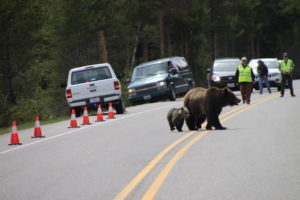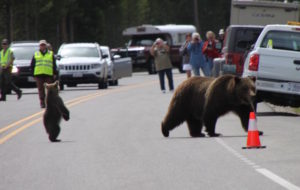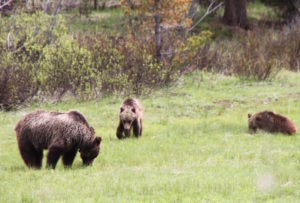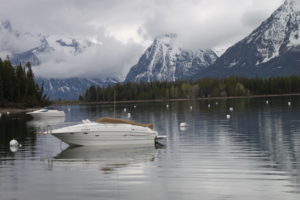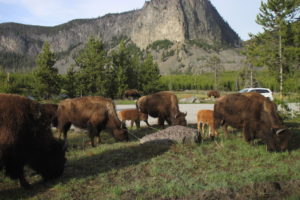The Greater Yellowstone Ecosystem is home to an estimated 700 grizzly bears, according to the Humane Society of the United States (HSUS). The number of bears in this ecosystem (which includes Yellowstone and Grand Teton national parks) had fallen to an estimated 136 when, in 1975, grizzlies in the lower 48 were listed as threatened under the Endangered Species Act.
In the years that followed, the bears were not hunted; we humans got smarter about avoiding conflict with them, and the animals had access to abundant food in the two national parks. By the standards of the slow-to-reproduce grizzlies, their population soared for two and a half decades. However, from about 2002, their numbers have been essentially flat, largely from loss of important foods, including cutthroat trout, and the resulting risks grizzlies take to find other food. At least 115 have died in the last two years alone.
Now (early 2017), the U.S. Fish and Wildlife Service is proposing to delist the bears and permit trophy hunting.
I did not know all of this when, last spring (meaning May of 2016), my family and I were among the 4 million to 5 million tourists who visit the Yellowstone and Grand Teton parks yearly to see grizzlies and other natural wonders.
Seeing these bears is quite a production, both for the visitors and the park rangers. Most grizzlies are collared so the rangers always know when they show up near a road. Rangers appear at such times, to protect both grizzlies and humans and to prevent chaos.
I saw grizzlies twice, both times in the Grand Teton National Park. At our first stop in this park, my younger nephew learned where grizzlies had been spotted on the previous two days. The destination was Signal Mountain Road, and we wasted no time getting there.
And what a payoff! We stopped where there were about four other cars and at least one ranger. Eventually, there were many more cars plus one or more additional rangers for stopping traffic as needed and letting visitors stand in the road to take photos. When a ranger told our clutch of grizzly fans that “if the bears come closer, you will have to move back,” my older nephew shot back, “You’ve got that right.”
We watched the area’s most famous mama grizzly (No. 399, the number on her collar) and her quite young cub cross the road. The cub was really funny as he stood up on its hind legs to look around at the humans.
In addition, someone alerts professional photographers to good sightings. They flocked to this scene with lenses the size of cannons.
The photo op featuring a bear cub was irresistible. I took 82 pictures on this occasion, but trashed 28 immediately, then culled further on the computer, leaving a “mere” 47.
On the next day’s outing, a second sighting centered on No. 610, the second-most-famous of the area grizzlies and No. 399’s daughter. She had two cubs, aged about 18 months. This bear sighting was no less exciting because it was the second! After editing, I still have another 38 photos, and I don’t absolutely need all of those either.
Two pieces of sad news must follow. For one, if people are allowed to trophy hunt grizzlies, Nos. 399 and 610 — when they seek food outside the parks — are among those most likely to be shot first because they, while far from tame, are accustomed to humans. In other words, the bears that help lure millions of tourists and their many millions of dollars to Idaho, Montana and Wyoming, would be the first to go.
Second, about a month after I saw No. 399’s cub, it was killed by a hit-and-run driver, tragically illustrating the hazards of life for grizzlies in a world manipulated by humans, even without hunters in the mix.
Wayne Pacelle, HSUS president and CEO, in a Dec. 30, 2016, blog, raised numerous arguments for continuing current protections for the bears including popular opinion: In a spring 2016 survey, 55% of Americans opposed delisting the bears with only 26% in favor; 67% opposed hunting with only 20% in favor.
Further, the HSUS reports, the U.S. Fish and Wildlife Service received a whopping 650,000 comments on the issue, most of them opposed to delisting grizzlies. Also, more than 125 Native American tribes in the U.S. and Canada called for continued protection for the grizzlies, which are central to their creation stories.
As a result of this overwhelming response, a U.S. Fish and Wildlife Service official said this week it will take another six months to evaluate all the comments.
I have comments, too. Over a 40-year period, the federal government, according to HSUS stats, spent “tens of millions” of dollars to bring grizzlies back from the edge. The payoff has been increased grizzly numbers, an enriched ecosystem and, for millions of people each year, the pleasure of seeing an American icon and fabulous example of the animal kingdom.
I would argue taxpayers did not spend those tens of millions to benefit a tiny number of people who would ruin viewing opportunities by destroying these majestic animals, then displaying their dead heads on a wall.
After which the rescue would have to start all over again.
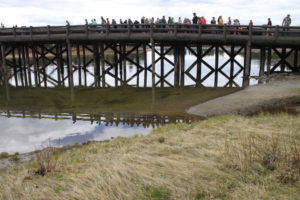
Fishing Bridge, which crosses the Yellowstone River in Yellowstone National Park. It has it name from a time when anglers crowded onto the bridge to fish for cutthroat trout, once an important food source for grizzlies. The fishing was halted in 1973 to save the species — ironically, since destroyed by invasive lake trout. Visitors still flock to the bridge, as in this photo, but for the views.
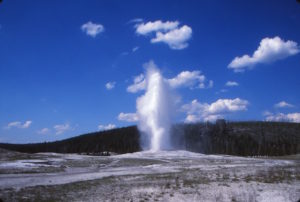
Old Faithful, the geyser every Yellowstone visitor has to see. Nothing produces a mob viewing situation like a grizzly, but I cannot resist adding a few photos of other scenes in Yellowstone and Grand Teton national parks.
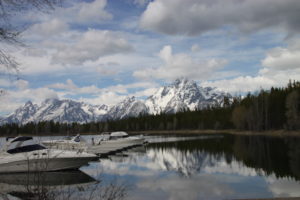
Scene at Colter Bay Village on the shore of Jackson Lake in Grand Teton National Park, with the eponymous mountains providing an over-the-top scenic view.
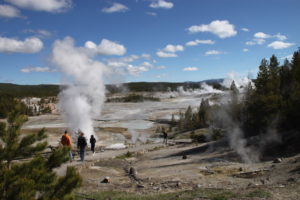
The Norris Geyser Basin, an otherworldly vision of hydrothermal activity in Yellowstone National Park. This site was a surprise favorite for me.
Summer 2018 postscript: The grizzlies were delisted. Idaho and Wyoming plan their first grizzly hunts for this fall. I am devastated and worried about the prospects of No. 399, No. 610, their cubs and all the other grizzlies in the Greater Yellowstone Ecosystem. My view, as is obvious, is that delisting these animals is a mistake. It will be regretted — after too many lie dead of bullet wounds.
For more about Yellowstone and area, we offer at BestTripChoices.com the following, under the headline: Hot springs and summer snow https://besttripchoices.com/us-touring-areas/yellowstone-national-park-beartooth-highway-montana/
This blog and photos are by Nadine Godwin, BestTripChoices.com editorial director and contributor to the trade newspaper, Travel Weekly. She also is the author of “Travia: The Ultimate Book of Travel Trivia.”

